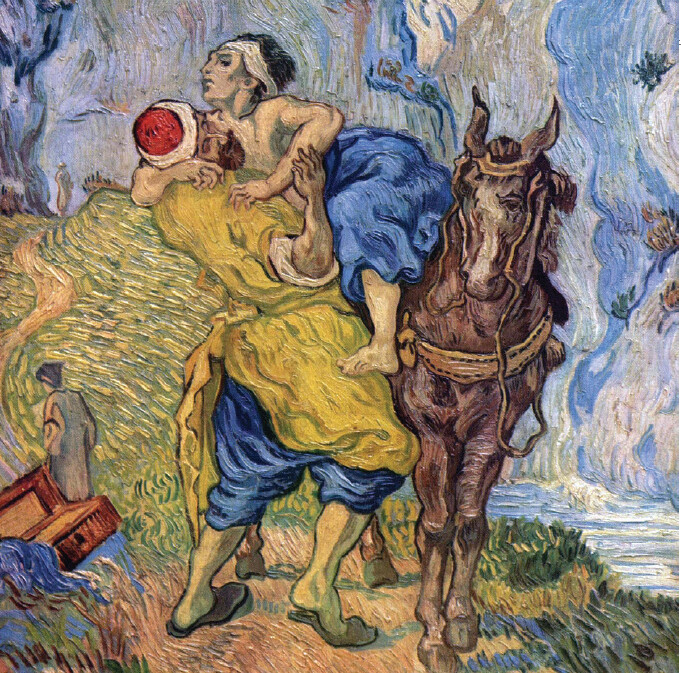The Good Samaritan—which some would describe as the most well-known and beloved of all the parables—is a literary jewel. It is found only in Luke’s gospel. In the beginning of Luke 10, we are told that Jesus had called 70 men and sent them out two-by-two as missionaries to teach the gospel. Some time later, the 70 returned with joy and announced that even the devils were subject unto them (see Luke 10:17).
Luke reported that Jesus “rejoiced in spirit” at this time (Luke 10:21) and privately told His disciples that they were blessed to see all of these things happen.
What immediately follows in Luke’s record was an incident that led Jesus to give the parable of the good Samaritan. A lawyer who had come to hear Jesus teach asked Him this question: “What shall I do to inherit eternal life?” (Luke 10:25).
This was a question the rabbis loved to debate in their schools. Sometimes they expressed that more explicitly as, “Which of all the commandments is the most important for me to keep if I am to have eternal life?”
Jesus turned the question right back on the seeker. “What is written in the law? How readest thou?” (Luke 10:26). He was a lawyer, supposedly an expert in the Mosaic law. So what did he think?
The lawyer immediately answered, citing scriptures from the Old Testament: “Thou shalt love the Lord thy God with all thy heart, and with all thy soul, and with all thy strength, and with all thy mind; and thy neighbor as thyself” (Luke 10:27; see also Deuteronomy 6:4–5; Leviticus 19:18). To which the Savior said, “Thou hast answered right: this do, and thou shalt live” (Luke 10:28).
Not satisfied with that, the lawyer asked another question: “And who is my neighbour?” (Luke 10:29).
When we think about it, this last question is quite revealing about the lawyer’s character. By asking who his neighbor was, he was asking, “So who do I have to love?” Which also comes with a flip side. “Who can I not love and still be acceptable to God?”
Jesus’s answer was the story of the good Samaritan.
The Parable
“And Jesus answering said, A certain man went down from Jerusalem to Jericho, and fell among thieves, which stripped him of his raiment, and wounded him, and departed, leaving him half dead.
“And by chance there came down a certain priest that way: and when he saw him, he passed by on the other side. And likewise a Levite, when he was at the place, came and looked on him, and passed by on the other side.
“But a certain Samaritan, as he journeyed, came where he was: and when he saw him, he had compassion on him, And went to him, and bound up his wounds, pouring in oil and wine, and set him on his own beast, and brought him to an inn, and took care of him. And on the morrow when he departed, he took out two pence, and gave them to the host, and said unto him, Take care of him; and whatsoever thou spendest more, when I come again, I will repay thee (Luke 10:30–35).”
That ends the formal parable, but not Jesus’s teaching of the lawyer who had asked the question. He asked the lawyer His own question. “Which now of these three, thinkest thou, was neighbour unto him that fell among the thieves? And he said, He that shewed mercy on him. Then said Jesus unto him, Go, and do thou likewise” (Luke 10:36–37).
Analysis
The first thing to note is that this parable does not have quite the same parallel structure found in other parables. Some experts have wondered if this was a true story and not a parable because it is more of a narrative than other parables. We don’t know the answer to that, but here is something else to consider: When Jesus taught these parables, He was speaking to people of the same culture as He was; who lived in the same area that He did; who spoke the same language as He did; who knew the same history as He did; and who, for the most part, held to the same religious beliefs as He did.
We modern readers come from a very different time, a very different culture, a very different religion, and most of us do not know many details of their history. And in this case, knowing more [about these things] helps us more fully understand the impact of what Jesus taught that day.
First, the setting. Jesus described the road from Jerusalem to Jericho as going “down.” That general description understates the actual area. The city of Jerusalem is nestled on top of a mountain ridge that runs through the central part of the Holy Land. The Mediterranean Sea is about 20 or so miles to the west, and the Dead Sea about the same distance to the east. That ridge is about 2,500 feet above sea level. Jericho, on the other hand, sits in the Jordan Valley near the north end of the Dead Sea, which is the lowest spot on the face of our planet. Jericho has an elevation of about 850 feet below sea level. The distance from Jerusalem to Jericho is only about 15 miles, which means that road drops over 3,000 feet in only 15 miles!
Anciently, the road led through a series of deep, narrow wadis, or canyons, that cut their way through the Judean wilderness. Even today, much of it is a barren, isolated, and uninhabited wilderness where only a few widely scattered Bedouin families herd their sheep and goats.
This topography and its isolation made a perfect place for robbers and brigands to lie in wait and attack isolated travelers. Because of this danger, people usually did not travel the road alone. So to hear of a traveler alone on that road would have been shocking to the Savior’s listeners. . . .
Keep in mind that the Samaritan is also alone out there on that desolate and dangerous stretch of road. Even stopping for a moment put him in immediate danger. But that did not deter him from having compassion on the man. Note how Jesus described the Samaritan’s efforts:
He went to him.
He bound up his wounds, pouring in oil and wine (to disinfect and help heal the wounds).
He set him on his own beast, likely a donkey.
He took him to an inn (which could have been miles away).
He stayed overnight at the inn and cared for him.
Though he had to continue on his own journey the next day, he paid the innkeeper the costs accrued, charged him to care for the victim until he was better, and promised to pay him more if needed when he came back that way again. Talk about going the extra mile. That would have been astounding for a Jew. But for a Samaritan to do that for a Jew? Incredible!
We don’t know if this lawyer had heard Jesus preach before that “all things whatsoever ye would that men should do to you, do ye even so to them” (Matthew 7:12). But that was exactly what the Samaritan had done for the victim.
Application
With that background, we can better appreciate what immediately followed. Jesus now turned back to the lawyer, who very likely was reeling a little from what he had just heard. This was the same man who had asked Jesus, “Who is my neighbor?” or in other words, “Who am I required to love?” Now Jesus asked him to answer his own question: “Which now of these three, thinkest thou, was neighbour unto him that fell among the thieves?” (Luke 10:36).
It must have been a painful question for the lawyer, for there was obviously only one answer to that, and he knew it. “And he said, He that shewed mercy on him” (Luke 10:37).
In one of those tiny details we find in the parables that reveal so much about people’s character, note that the lawyer did not answer with, “The Samaritan.” It’s as if even saying that word was so painful to him that he couldn’t bring himself to do it. So instead he described his actions. “He that shewed mercy.”
Jesus found that answer acceptable: “Then said Jesus unto him, Go, and do thou likewise” (Luke 10:37).
In this simple but powerful parable, we are introduced to five typical attitudes often found in human nature that determine how we interact with those in need.
The injured victim: “I am in need. Help me!”
The thieves: “What’s yours is ours if we are strong enough to take it.”
The priest and Levite: “What’s mine is mine and I’m going to keep it.”
The innkeeper: “What’s mine is yours if you can pay for it.”
The Samaritan: “What’s mine is yours if you need it.”
At the synagogue in Nazareth [when He declared He was the Messiah], Jesus defined one of the things that He had come to earth to do. He came to minister to others.1 . . . While His primary purpose in coming to Earth was to make an infinite Atonement for all of God’s children and give them the opportunity to return to the presence of our Heavenly Father, He also came to set a perfect example for us on how to live so that we could do that. And a major part of that “how to live” counsel was learning to minister to others. The Savior set the standard for all of us when He asked, “Therefore, what manner of men ought ye to be?” The answer was simple and unmistakably clear: “Verily I say unto you, even as I am” (3 Nephi 27:27).
And in the parable of the good Samaritan, He gives us a model of how to do that.
Our modern prophets, seers, and revelators have echoed that charge: President Gordon B. Hinckley summed up the lesson of this parable with this simple reminder: “There are so many who have been injured and who need a good Samaritan to bind up their wounds and help them on their way. A small kindness can bring a great blessing to someone in distress and a sweet feeling to the one who befriends him.”2
President M. Russell Ballard focused on the Savior’s words to the lawyer to “Go and do” and added these insights:
“Our latter-day prophets are well known for such phrases as ‘Let’s get going,’ ‘Do it,’ ‘Do it now.’ I have heard President Gordon B. Hinckley say that the only way he knows to get things done is to first get on his knees and pray, and then to get on his feet and go do the work. That driving desire to ‘go’ and ‘do’ has been the hallmark of our prophet-presidents all of their lives. Of course, ‘going and doing’ isn’t always easy or comfortable. Occasionally it requires some sacrifice on our part—of time, energy, or personal will. But it is almost always worth whatever effort we make, especially if it has to do with following the instructions of inspired council leaders in seeking to bring souls to Christ.”3
The Parables of Jesus: Mirrors to the Soul, Windows to Eternity
Notes
1. See Luke 4:18–19.
2. Teachings of Gordon B. Hinckley, (1997), 287.
3. M. Russell Ballard, Counseling with our Councils, (1997), 32.



